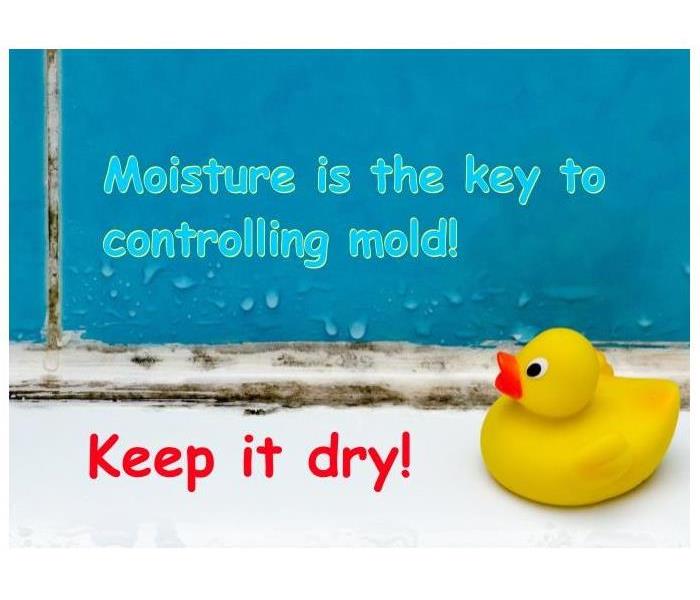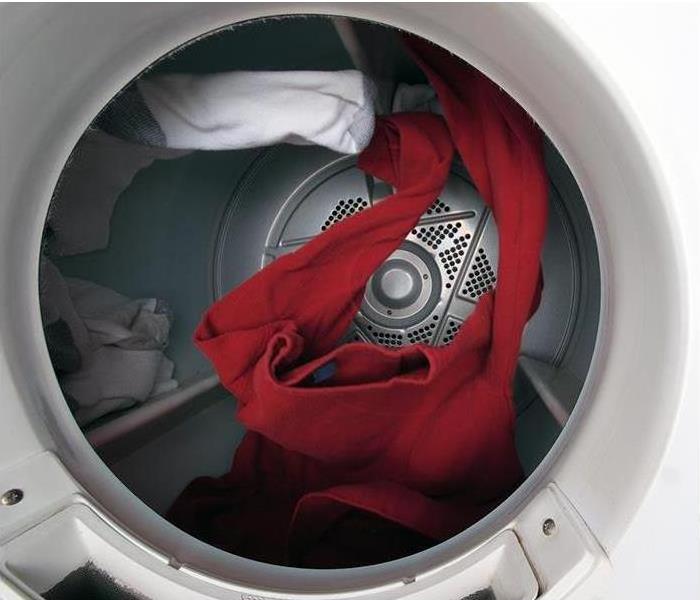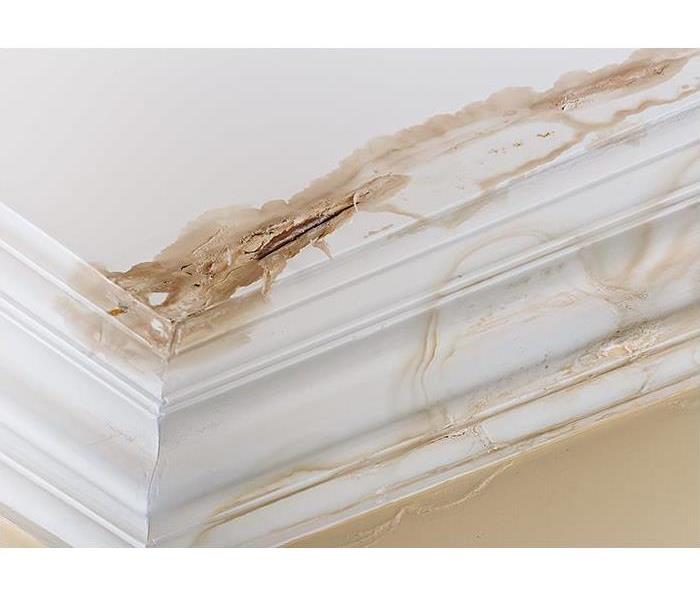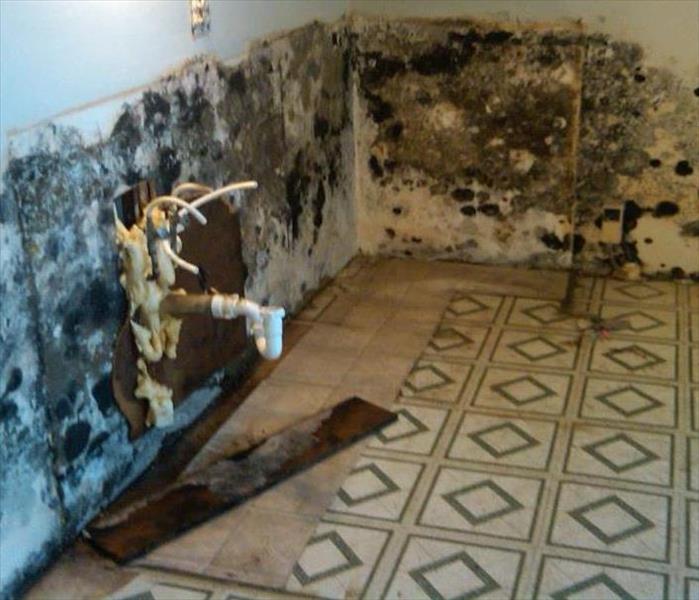Recent Mold Remediation Posts
Summer Showers Bring Green Grass & Flowers....AND MOLD!
7/17/2018 (Permalink)
 Don't feed the mold.Keep you home dry!
Don't feed the mold.Keep you home dry!
There is always some mold everywhere – in the air and on many surfaces. Molds have been on the Earth for millions of years. Mold grows where there is moisture.
Mold and Your Health
Exposure to damp and moldy environments may cause a variety of health effects, or none at all. Some people are sensitive to molds. For these people, molds can cause nasal stuffiness, throat irritation, coughing or wheezing, eye irritation, or, in some cases, skin irritation. People with mold allergies may have more severe reactions. Immune-compromised people and people with chronic lung illnesses, such as obstructive lung disease, may get serious infections in their lungs when they are exposed to mold. These people should stay away from areas that are likely to have mold, such as compost piles, cut grass, and wooded areas.
In 2004 the Institute of Medicine (IOM) found there was sufficient evidence to link indoor exposure to mold with upper respiratory tract symptoms, cough, and wheeze in otherwise healthy people; with asthma symptoms in people with asthma; and with hypersensitivity pneumonitis in individuals susceptible to that immune-mediated condition. The IOM also found limited or suggestive evidence linking indoor mold exposure and respiratory illness in otherwise healthy children.
In addition, in 2004 the IOM found sufficient evidence to link exposure to damp indoor environments in general to upper respiratory tract symptoms, cough, and wheeze in otherwise healthy people and with asthma symptoms in people with asthma. The IOM also found limited or suggestive evidence linking exposure to damp indoor environments in general to shortness of breath, to respiratory illness in otherwise healthy children and to potential development of asthma in susceptible individuals. In 2009, the World Health Organization issued additional guidance, the WHO Guidelines for Indoor Air Quality: Dampness and Mold [PDF – 2.65 MB]. Other recent studies have suggested a potential link of early mold exposure to development of asthma in some children, particularly among children who may be genetically susceptible to asthma development, and that selected interventions that improve housing conditions can reduce morbidity from asthma and respiratory allergies, but more research is needed in this regard.
Mold and Your Home
Mold is found both indoors and outdoors. Mold can enter your home through open doorways, windows, vents, and heating and air conditioning systems. Mold in the air outside can also attach itself to clothing, shoes, bags, and pets can and be carried indoors.
Mold will grow in places with a lot of moisture, such as around leaks in roofs, windows, or pipes, or where there has been flooding. Mold grows well on paper products, cardboard, ceiling tiles, and wood products. Mold can also grow in dust, paints, wallpaper, insulation, drywall, carpet, fabric, and upholstery.
You Can Control Mold
Inside your home you can control mold growth by:
- Controlling humidity levels;
- Promptly fixing leaky roofs, windows, and pipes;
- Thoroughly cleaning and drying after flooding;
- Ventilating shower, laundry, and cooking areas.
Mold growth, which often looks like spots, can be many different colors, and can smell musty. If you can see or smell mold, a health risk may be present. You do not need to know the type of mold growing in your home, and CDC does not recommend or perform routine sampling for molds. No matter what type of mold is present, you should remove it. Since the effect of mold on people can vary greatly, either because of the amount or type of mold, you cannot rely on sampling and culturing to know your health risk. Also, good sampling for mold can be expensive, and standards for judging what is and what is not an acceptable quantity of mold have not been set. The best practice is to remove the mold and work to prevent future growth.
MOLD PREVENTION TIPS
- Keep humidity levels as low as you can—no higher than 50%–all day long. An air conditioner or dehumidifier will help you keep the level low. Bear in mind that humidity levels change over the course of a day with changes in the moisture in the air and the air temperature, so you will need to check the humidity levels more than once a day.
- Be sure your home has enough ventilation. Use exhaust fans which vent outside your home in the kitchen and bathroom. Make sure your clothes dryer vents outside your home.
- Fix any leaks in your home’s roof, walls, or plumbing so mold does not have moisture to grow.
- Clean up and dry out your home thoroughly and quickly (within 24–48 hours) after flooding.
- Add mold inhibitors to paints before painting.
- Clean bathrooms with mold-killing products.
- Remove or replace carpets and upholstery that have been soaked and cannot be dried promptly. Consider not using carpet in rooms or areas like bathrooms or basements that may have a lot of moisture.
- To learn more about preventing mold in your home, see the Environmental Protection Agency’s publication A Brief Guide to Mold, Moisture, and Your Home [PDF – 1.38 MB].
If you have questions about mold that you find in your home and need it removed, call us, SERVPRO of Glenview at 847-832-9300!
Moldy Clothes? What Can You Do?
5/22/2018 (Permalink)
 Your Dryer Is Your Friend!
Your Dryer Is Your Friend!
The reason clothing is so susceptible to mold growth is not just because of the mold-inviting circumstances within the laundry room. Generally, when it is worn, clothing collects sweat and skin cells, as well as dirt and other forms of moisture and organic material that mold loves to feast on. Then, it is placed in the laundry hamper and usually sits for days before it it is finally washed. This scenario is typical and may not result in a noticeable mold infestation, but should the soiled laundry be allowed to fester long enough, a mildew smell may be present, as well as visible signs of green, blue, gray, black, or sometimes even white mold on clothes.
Another scenario is becoming more common due to busy lifestyles and poor habits. The quick development of mold on clothes after washing may be surprising to some, but it is quite an ordinary occurrence for those with overwhelmed schedules or those who are vulnerable to procrastination because they often forget to remove clothing from the washing machine once the cycle is finished. As time passes, this leads to the rapid proliferation of mildew and mold on clothes after washing, due to the remaining moisture. Neglecting to put the wet clothes in the dryer for a few hours is not what makes mold grow. Neglecting the clothes in the washer for 6 hours or longer–sometimes a day or even a few days–is the problem. Before too long, a mildew smell will be detected in the washer and clothing. Some assume this is the residue of soap, and while that may be true to some extent, the fact of the matter is that most soaps contains lard and other organic (even synthetic) materials that mold can thrive off of. The smell is not necessarily the residue of soap, but an indication that mold is producing a secondary metabolite–the mildew smell–from consuming that soap.
What is a natural detergent to kill mold? Here is what you will need.
- Two 5 oz. organic castile soap bars (naturally-scented with lavender or peppermint is great but non-scented works just the same)
- 3 cups of washing soda (no, it’s not the same as baking soda)
- 2 cups of borax
- 30 drops of certified-pure lavender essential oil (optional but highly advisable for a mold killing laundry detergent)
Once you have all the materials, this is what to do.
- Cut the castile soap bars into small pieces or chunks. (This is crucial to avoid damaging the food processor.)
- Place the cut castile soap pieces or chunks in the food processor bowl. Pulse the soap on high until what remains are large crumbs.
- Add the washing soda to the food processor and pulse for 1 minute. (After pulsing, all the ingredients should be in powder form and well-combined. If not, try running the food processor again and then mixing with a spoon.)
- Empty the washing soda and castile soap into the storage container. Add the borax and blend well with a spoon.
- Add the essential oils of choice (optional but beneficial) and be sure to mix well.
Do not place this mixture into the drawer or dispenser, place it directly in with the laundry.
GOT MOLD?!
5/9/2018 (Permalink)
 Hmmmm...What nasty stuff is lurking within THIS corner and why!
Hmmmm...What nasty stuff is lurking within THIS corner and why!
Overview
Mold is a major-league nuisance. It blackens the grout lines in your shower, discolors drywall, shows up as black spots on siding, darkens decks, and grows on and rots damp wood everywhere. Even worse, it can be bad for your health. Mold releases microscopic spores that cause allergic reactions, runny noses and sneezing, as well as irritating, even injurious, odors
If you have seepage or a leak that hasn’t been addressed, mold may have infiltrated the drywall and internal surfaces of your home. Disturbing big infestations can be bad for your health, particularly if you are an allergy sufferer or have a weakened immune system. When you discover an extensive mold problem, we recommend that you call in a professional, who knows what kills mold, to handle the problem of how to remove it and stop it at its source. And even if you hire professionals, read through this article to understand how to keep the mold from spreading throughout your house.
How to identify mold
Mold is everywhere. It’s a type of fungus that grows from tiny spores that float in the air. It can grow almost anywhere that spores land and find moisture and a comfortable temperature, between 40 and 100 degrees F. Typically that includes about every damp place in your home.
You can easily spot the most visible type of mold, called mildew, which begins as tiny, usually black spots but often grows into larger colonies. It’s the black stuff you see in the grout lines in your shower, on damp walls, and outdoors on the surfaces of deck boards and painted siding, especially in damp and shady areas. A mildewed surface is often difficult to distinguish from a dirty one. To test for mildew, simply dab a few drops of household bleach on the blackened area. If it lightens after one to two minutes, you have mildew. If the area remains dark, you probably have dirt.
Mildew is a surface type of mold that won’t damage your home’s structure. But other types of mold cause rot. Probe the suspect area with a screwdriver or other sharp tool. If the wood is soft or crumbles, the fungi have taken hold and rot has begun.
If you have a high concentration of mold, you may smell it. If you detect the typical musty odor, check for mold on damp carpets, damp walls, damp crawlspaces and wet wood under your floors, wet roof sheathing and other damp areas. Have these infestations cleaned right away before they get worse.
Tips for Mold Prevention
After the mold is removed from your home, you’ll want to prevent it in the future. The key to stopping most mold is to control dampness. The worst infestations usually occur in damp crawlspaces, in attics and walls where water has leaked in from the outside, and in basements with poor foundation drainage. Stopping leaks, ensuring good ventilation in attics, keeping crawlspaces dry and routing water away from the foundation are the best defenses on how to get rid of mold.
Mildewcide in paint is usually effective for controlling surface mold in damp rooms like bathrooms and outside in shady areas. Many paints already have mildewcide in them. Check with your paint dealer to be sure.
Call a Pro!
If you find mold in your home and have questions or are concerned about the extent of the problem, call SERVPRO of Glenview at 847-832-9300 and we will be glad to do a detailed inspection to find the source of the mold and give you advice about what should be done.
Glenview Residents: Follow These Mold Safety Tips If You Suspect Mold
6/26/2017 (Permalink)
 Be careful! Without proper training, you could be spreading mold throughout your home.
Be careful! Without proper training, you could be spreading mold throughout your home.
If you see visible mold, do not disturb it. You can inadvertently spread the mold infestation throughout your home. When mold is disturbed, the mold can release microscopic mold spores which become airborne and can circulate inside your home.
What to Do:
- Stay out of affected areas.
- Turn off the HVAC system and fans.
- Contact SERVPRO of Glenview for mold remediation services.
What Not to Do:
- Don’t touch or disturb the mold.
- Don’t blow air across any surfaces with visible or suspected mold growth.
- Don’t attempt to dry the area yourself.
- Don’t spray bleach or other disinfectants on the mold.
About Our Mold Remediation Services
SERVPRO of Glenview specializes in mold cleanup and restoration, in fact, it’s a cornerstone of our business. Our crews are highly trained restoration professionals that use specialized equipment and techniques to properly remediate your mold problem quickly and safely.
If You See Signs of Mold, Call Us Today – 847-832-9300
Does Your Glenview Home Have A Mold Problem?
7/7/2016 (Permalink)
Microscopic mold spores naturally occur almost everywhere, both outdoors and indoors. This makes it impossible to remove all mold from a home or business. Therefore, mold remediation reduces the mold spore count back to its natural or baseline level. Some restoration businesses advertise “mold removal” and even guarantee to remove all mold, which is a fallacy. Consider the following mold facts:
? Mold is present almost everywhere, indoors and outdoors.
? Mold spores are microscopic and float along in the air and may enter your home through windows, doors, or AC/heating systems or even hitch a ride indoors on your clothing or a pet.
? Mold spores thrive on moisture. Mold spores can quickly grow into colonies when exposed to water. These colonies may produce allergens and irritants.
? Before mold remediation can begin, any sources of water or moisture must be addressed. Otherwise, the mold may return.
? Mold often produces a strong, musty odor and can lead you to possible mold problem areas.
? Even higher-than- normal indoor humidity can support mold growth. Keep indoor humidity below 45 percent.
If your home or business has a mold problem, we can inspect and assess your property and use our specialized training, equipment, and expertise to remediate your mold infestation.
If You See Signs of Mold, Call Us Today
(847) 832-9300





 24/7 Emergency Service
24/7 Emergency Service



